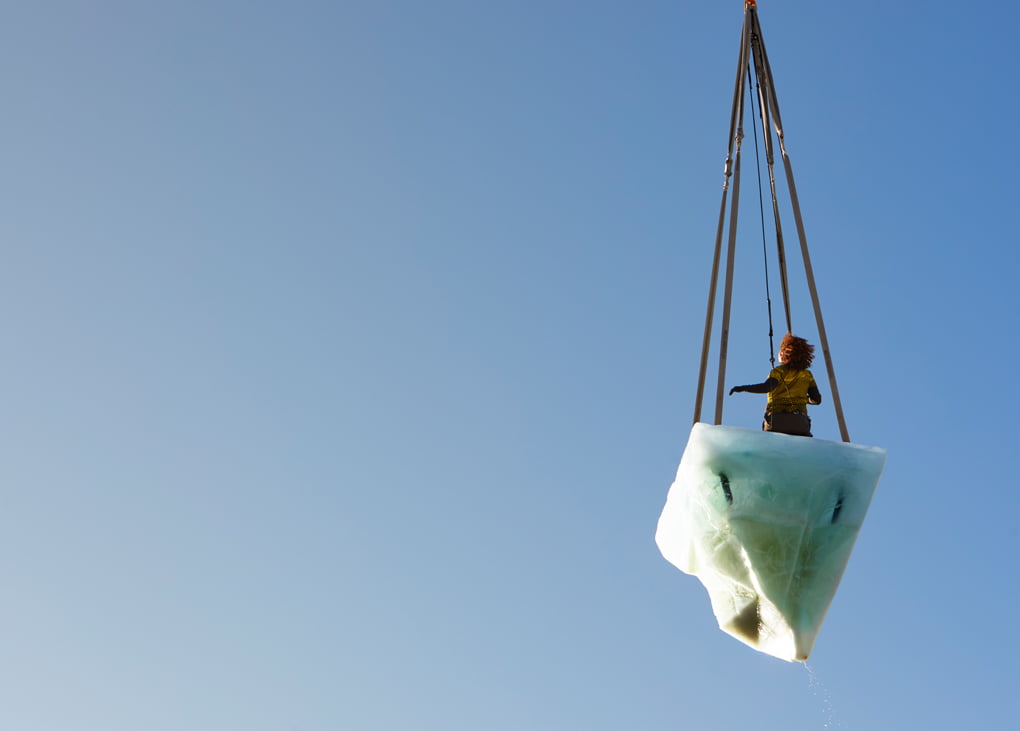One of the highlights of this year’s Sydney Festival puts climate change centrestage with the help of a block of ice weighing almost three tonnes – and close collaboration between artists, engineers and crane operators.
The performance, titled Thaw, is performed over 10 hours in one day, and sees a lone woman on a huge block of sculpted ice, suspended 20m over the waters of Sydney Harbour, from the foot of the Sydney Opera House.
During the performance, as the ice melts and the crane moves around, the audience sees the performer scramble to protect her “home”.
Sydney-based physical theatre company Legs On The Wall created the work to reflect on our individual roles in the climate emergency and our collective obligation to a sustainable future.
Given the scale of the performance, Legs On The Wall sought expert engineering input to take the project from concept to execution, from both Ironbridge Engineering and Active Crane Hire.
“We’re not in the business of making giant ice blocks ordinarily,” says Thaw’s Creative Producer Cecily Hardy. “But we did work out pretty quickly that we didn’t want to outsource the ice.
“It would have been quite an expensive operation. Also we needed to be in control of the apparatus, and how it behaves when the performers are on it. We have this extra element, where if things aren’t done properly, people’s lives are most definitely at risk.”
The team embarked on a process of learning how to create the ice blocks, starting with small moulds and gradually making them larger.
“We went into quite an unknown new territory of discovering how ice behaves,” says Hardy, “and then how ice behaves with rigging, and then how ice behaves with rigging, suspended, and then how all of that happens in the weather. We discovered all kinds of things in terms of the effect when it froze too quickly or when the mould was too full.”
Once confident in the process, the team manufactured a mould in steel. Because Thaw is performed over multiple days, they have to manufacture a minimum of four ice blocks, using 20- and 40-foot container freezers. Each block takes around 11 days to freeze properly, and this must be done in stages to ensure the integrity of the ice and how it behaves once it is dangling for 8–10 hours during the day.
Going into the performance, the team is still not totally sure what will happen – which forms part of the spectacle.
“It’s nerve-wracking of course to do something we’ve never done before and push into totally new territory, to be brave and interesting and do something that will inspire people,” says Hardy.
“But equally it’s incredibly well thought out and can respond properly in the elements in terms of the wind factor and different weather conditions and how the ice might behave throughout the day in the summer sun.”
Hardy says one of the most pleasing things to come out of the project has been the way different disciplines have worked together.
“The engineers have just enough patience for us and our crazy artistic ideas,” she says. “It actually has been this incredible collaboration because it wouldn’t be possible without them. They really are part of it. The crane driver is part of the choreography because you can’t separate the two – the movements of the performer, how the audience feels if the crane’s moving fast coming in at you, coming up, coming down. They’ve accidentally turned into some of the artists on the work, really.
“The project has been stronger for the mutual respect between the collaborators. I do think in that way it is a success story, which is exciting because it speaks to the fact that we could do it a bit more. It’s not without its hard work – it’s definitely finding a common language. But overall it speaks to the fact that there is probably more interesting and exciting spaces in that crossover.”
Thaw will be performed on January 14, 15 and 16 as part of the Sydney Festival, and live-streamed as part of Sydney Festival’s At Home digital program and on Sydney Opera House’s Stream platform. Saturday’s entire performance can be viewed as a live video feed on January 15 from 10am–8.30pm.
Image Shane Rozario.
 Mark Vender
Mark Vender


Leave a Reply